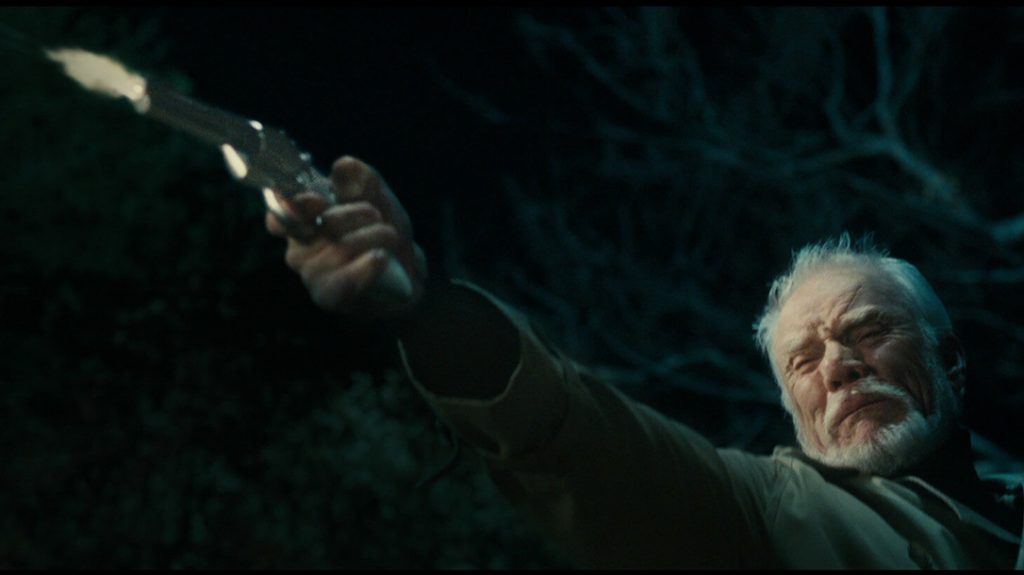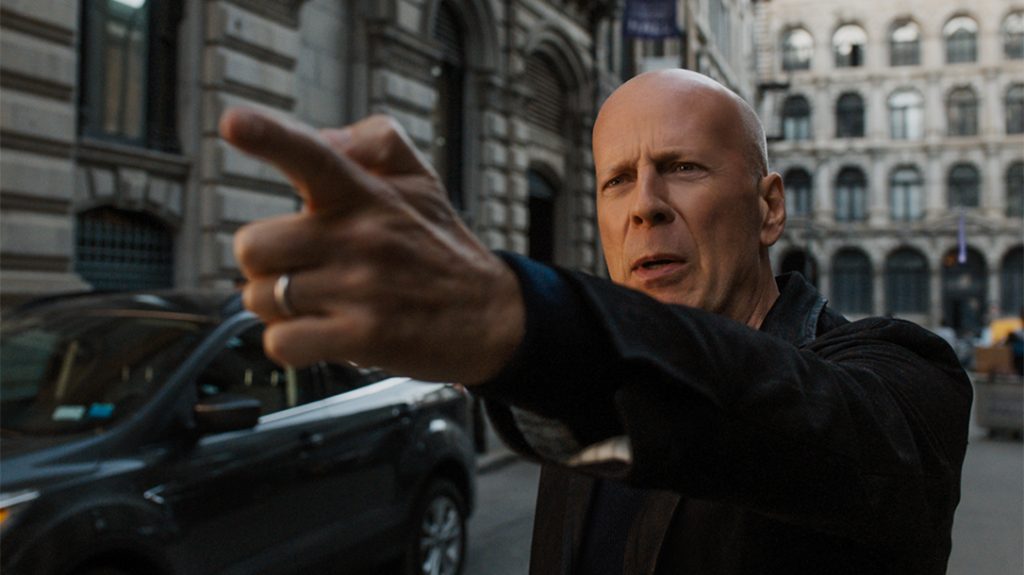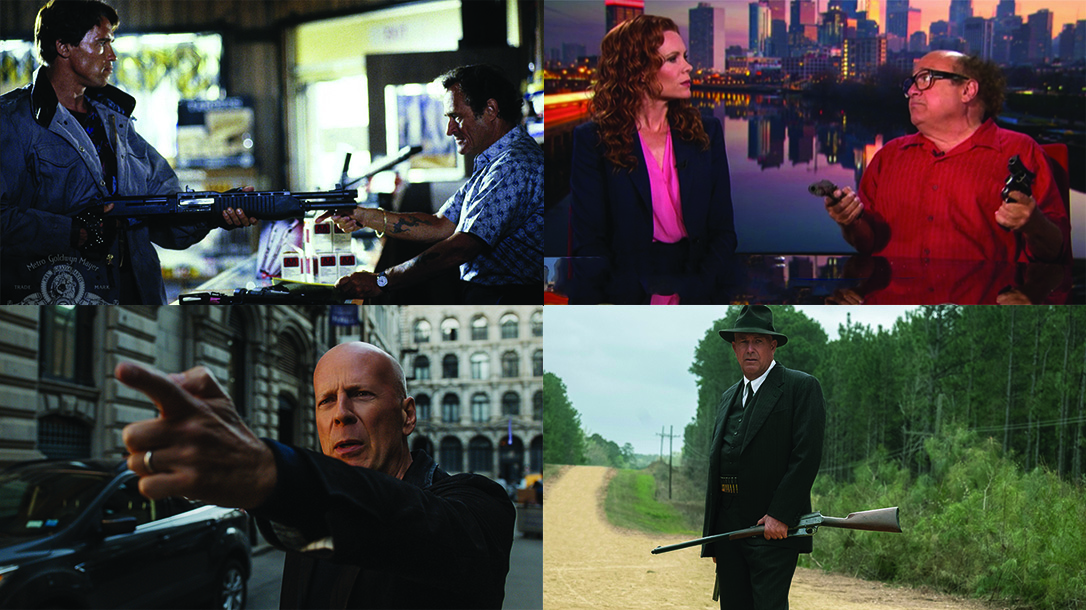There have always been guns in Hollywood. Ever since the first motion pictures were made, they depicted gunplay between cops and criminals, shootouts in the dusty streets of the Old West and wars. Accuracy of gun use in movies has varied wildly, but so has the depiction of another aspect of firearms—their purchase in a gun store.
Gun Store Scenes in the Movies
The depictions of buying a gun in film and on TV is often goofier than depictions of gun use. Here’s a rundown of some flicks that got it right, and some that got it very wrong. Realistic or not, these epic scenes are worth rating.
The Terminator (1984)
- A cyborg buys an arsenal
- GRADE: B-
This is one of the most legendary gun shop scenes of all time. In his break-through role, a young Arnold Schwarzenegger plays an evil cyborg sent back in time to 1984 from a dystopian future where people and the machines they created are at war. His mission is to kill the mother of the man who becomes the leader of the human resistance in the future. Naturally, he has to get some guns, so he heads to a gun shop.
Advertisement — Continue Reading Below
We’ve spoken about the guns of The Terminator before on this site. I suspect they filmed this scene in an actual gun shop, and a ludicrously well-stocked gun shop at that; the inventory felt more like that of a Hollywood prop master’s. The Alamo Sport Shop has awesome, big glossy logos of the era for Winchester, Ruger and Colt on the front, lending authenticity.
The Terminator asks for a “12-gauge autoloader”; the clerk hands him a Franchi SPAS-12, while he works the action on an AR-18 that he’s already holding. “That’s Italian. You can go pump, or auto.”
And he’s absolutely right. Franchi designed the SPAS-12 for law enforcement use. With that in mind, it had a selector switch that allowed the user to fire in semi-auto or pump action for lower-powered loads.
Advertisement — Continue Reading Below
When the cyborg asks for a “.45 longslide with laser sighting,” he’s presented with the gun that ended up on the movie poster. The clerk hands him an AMT Hardballer .45 Longslide pistol with what looks like a small silver Maglite mounted to the top via a bracket and a scope ring. Though laser sights weren’t commercially available at the time, making this gun super anachronistic, the film actually used a real laser sight, albeit a primitive one, made by a designer from the company that would become SureFire.
“These are brand new. We just got them in,” the clerk says. “That’s a good gun. Just touch the trigger, the beam comes on, and you put the red dot where you want the bullet to go. Can’t miss.” The Terminator also asks for an “Uzi 9mm” he sees on the gun rack. The clerk pulls down what looks to be a fairly stock Uzi, which is a problem. It should have a 16-inch barrel to have been sold legally at the time. We can imagine that the cyborg modified the semi-autos to fire in full-auto, and that should have been a carbine-length barrel in the story that he cut down later.
Advertisement — Continue Reading Below
They don’t really discuss the legality of the gun sales. The clerk does tell the cyborg he has to wait on the handguns, but he can take the long guns that day; that’s before the killing machine shoots he clerk with the SPAS-12.
The Highwaymen (2019)
- Frank Hamer stocks up on firepower
- GRADE: B+
It’s tough to tell a story that’s been told 100 times before and still come up with something original and interesting, but Netflix managed just that with this retelling of the tracking and killing of infamous 1930s outlaw couple Bonnie and Clyde from the perspective of two retired Texas Rangers.
Kevin Costner plays legendary lawman Frank Hamer. After accepting the job, one of his first stops is another remarkably well-stocked small-town gun shop. He knows his quarry is well armed, and he plans accordingly. Hamer consults a firearms catalog as he requests the following: a Thompson submachine gun, a Colt Monitor, a Smith & Wesson Model 1917 revolver, a 1918 BAR, a 1903 Springfield with scope, a Remington Model 11 shotgun and a Winchester 1894 lever gun in .30-30.
Advertisement — Continue Reading Below
Is this realistic? Mostly. This takes place in the first half of 1934, so it’s perfectly plausible that he could buy full-auto machine guns from a regular ol’ gun store; the infamous National Firearms Act of 1934 didn’t actually go into effect until June of that year. They killed Bonnie and Clyde in May.
What’s kind of bonkers is that the gun shop had all these items in stock, along with a hefty supply of spare magazines, ammunition and a Colt Monitor. There were only 125 of the cut-down, modified BARs ever produced, with most going to the U.S. Treasury Department and the FBI. The rest went to prisons and law enforcement entities. The gun was never commercially available, and the chances of a small-town gun store just having one on the wall a few months before the NFA went into effect is a bit far-fetched. Read more about the guns and gunplay of The Highwaymen here on BallisticMag.com.
Advertisement — Continue Reading Below
Halloween (2007)
- Dr. Loomis buys a revolver
- Grade: F
Gun people are not the only ones with gripes about Rob Zombie’s 2007 remake of John Carpenter’s 1970s classic Halloween. Dr. Sam Loomis, this time played by Malcolm McDowell, goes to an Illinois gun shop to buy his trademark revolver before hitting the streets of Haddonfield on Halloween night to hunt down his former patient, Michael Myers.
The very 1970s-looking gun store is staffed by a stereotypical unshaven beer-bellied dude in a vintage camo hat. “What about this big one here, that looks perfect,” Loomis exclaims, pointing to a long-barreled revolver revealed to be a “22 Smith & Wesson.”
“That’s OK if you wanna just piss it off. If you want to blow its f*cking’ head off, this is what you want: .357 Magnum,” says the clerk, while presenting a 4-inch Colt Python.
Advertisement — Continue Reading Below
Then he rattles off some specs, but not the ones you’d expect. Something about the mainspring, and that it has polygonal rifling, and says it has a muzzle velocity of 1,450 fps, though they haven’t talked about ammunition yet. The muzzle velocity of .357 Mag loads can range roughly between 1,200 and 1,700 fps. And while S&W does use polygonal rifling in some of its revolvers, I don’t think Colt ever did, especially in the Python.

But that’s not the worst part. This harried, tongue-tied customer, who knows absolutely nothing about guns and sports a prominent British accent, then says, “I’m in a bit of a hurry. If you could just wrap it up that would be great, thank you.”
Advertisement — Continue Reading Below
That’s all that’s required. He just buys a handgun in a state where he doesn’t live and walks out the door. To buy any gun in Illinois, you must have a state-issued FOID card. To get that, you must be a resident. The state also has a 72-hour waiting period on all firearm purchases, including handguns. But all the clerk says is, “What’re we huntin’?”
Death Wish (2018)
- Premise: Paul Kersey visits a Chicago gun store
- Grade: A
This is an underrated remake of the classic New York City vigilante exploitation flick, Death Wish (1974), originally starring Charles Bronson. This time, Bruce Willis plays Paul Kersey, reimagined as a trauma surgeon in Chicago. A violent home invasion devastates his family, leaving his wife dead and teenage daughter in a coma.
Paul decides to do something personally about the rampant violence in his city. After seeing a slightly hokey, but fairly accurate video for a local gun store online called Jolly Rogers, Kearsey pays them a visit—and, shocker, it actually looks like a gun shop with displays and logos of brands you will recognize, like SureFire, Cadex Defence, Blade Tech and F-1 Firearms.
Advertisement — Continue Reading Below

The store’s staffer, a young woman named Bethany, pegs him as a first-time buyer immediately. She then gives him a quick tour of the shop. “So, over here we have our bladed weapons. Behind me on this wall are all of our rifles, and each one comes with a free case and two PMAGs. And if you follow me over here (to the counter), all of our new pistols are there and all of our used weapons are right here.”
“Used?” Kersey asks.
“Well, not used in crimes, obviously, but you know, used,” she answers.
This is a great gun store scene. Bethany is not a stereotype, her sales pitch is genuine and the inventory is realistic. The scene really shines when Kersey says, “Forgive me for asking, but what is the process for all of this. There must be a lot of paperwork, right?” And the response is accurate!
Bethany says, “Oh, don’t even worry. We’ll get you set up with your FOID application, right here today. State police send it pretty quick. And then you’ll just have to take a gun safety class, but don’t worry, no one ever fails. You can do that any time within 30 days. In that time you’ll be waiting for your city permit. And then it’s just 72 hours and you’re cocked, locked and ready to rock. Oooh, and we can also set you up with a gun safe.”
It’s not a perfect response, but it’s pretty damn good. She accurately describes the steps for buying a gun in Chicago. However, she glosses over the associated fees and it’s not perfectly clear that the city permit is a separate step. She also doesn’t mention that every gun in the city has to be registered with the city within five days of purchase. But, for a movie that needs dialogue to flow, that’s pretty darn good, plus she mentions safe storage. Kudos to you, Eli Roth. Read more about the hardware, truths, and fallacies of the Death Wish remake on PersonalDefenseWorld.com.
It’s Always Sunny in Philadelphia – Gun Fever Too: Still Hot
- Premise: Dennis and Dee desperately try to buy an AR-15
- Grade: C+
For a show that skews pretty left most of the time regarding political issues, the comedy series’ approach to the gun control debate in the season nine episode, “Gun Fever Too: Still Hot” presents a surprisingly even take.
Half the gang, Mac and Charlie, jump on the pro-gun side and attempt to guard a school with a revolver and a katana (don’t ask). Dennis and Dee jump on the anti-gun train, determined to prove to their friends that it’s too easy to buy an assault rifle. When they attempt to buy an AR-15 at Gunther’s Guns, they say a few red-flag words about a “list” and call an AR-15 a “people killer.” That raises Gunther’s suspicions, which are confirmed when their NICS checks bounce back (inhumanly fast and bizarrely detailed, I might add).
The sale is denied, so they attempt to exploit the well-known “gun show loophole” by buying an AR from a private seller who tells them he won’t run a background check. But, when they offhandedly insult him, he quotes them a price of $3,000.
“Listen, I want this gun, pal,” Dennis says. “I want it. Because it’s easy to buy a gun, and I need to prove that to some people, so give me the gun at a fair price, and do it now.”
“Four thousand.”
“Really,” says Dennis while picking up the AR and aiming it at the seller. “How about I just take it, because I’m a maniac with a gun, and there’s nothing you can do about it.” Every attendee of the gun show, including the seller, pulls their concealed carry firearm, and the duo have about 50 guns pointed at them.
“OK. Oops. Putting the gun down now. This is just a, just an exercise, to prove how unsafe it is, for everyone to have guns. But I see now I was the maniac with the gun, and you all made it safer in here.”
Finally, they attempt to buy an AR from a dude on the street, who has previously sold them crack (don’t ask). He takes their money and simply walks away.
Dee tells Dennis to go stop him and he says, “The man has an assault rifle, what am I supposed to do? I can’t buy one!”
“The only thing that stops a bad guy with a gun is a good guy with a gun, which we can’t get!” Dee says. It’s a comedy, so it isn’t super accurate. But somehow, it’s not completely inaccurate either.
This article is from the Oct/Nov 2020 issue of Ballistic Magazine. Grab a print or digital subscription at OutdoorGroupStore.com.























